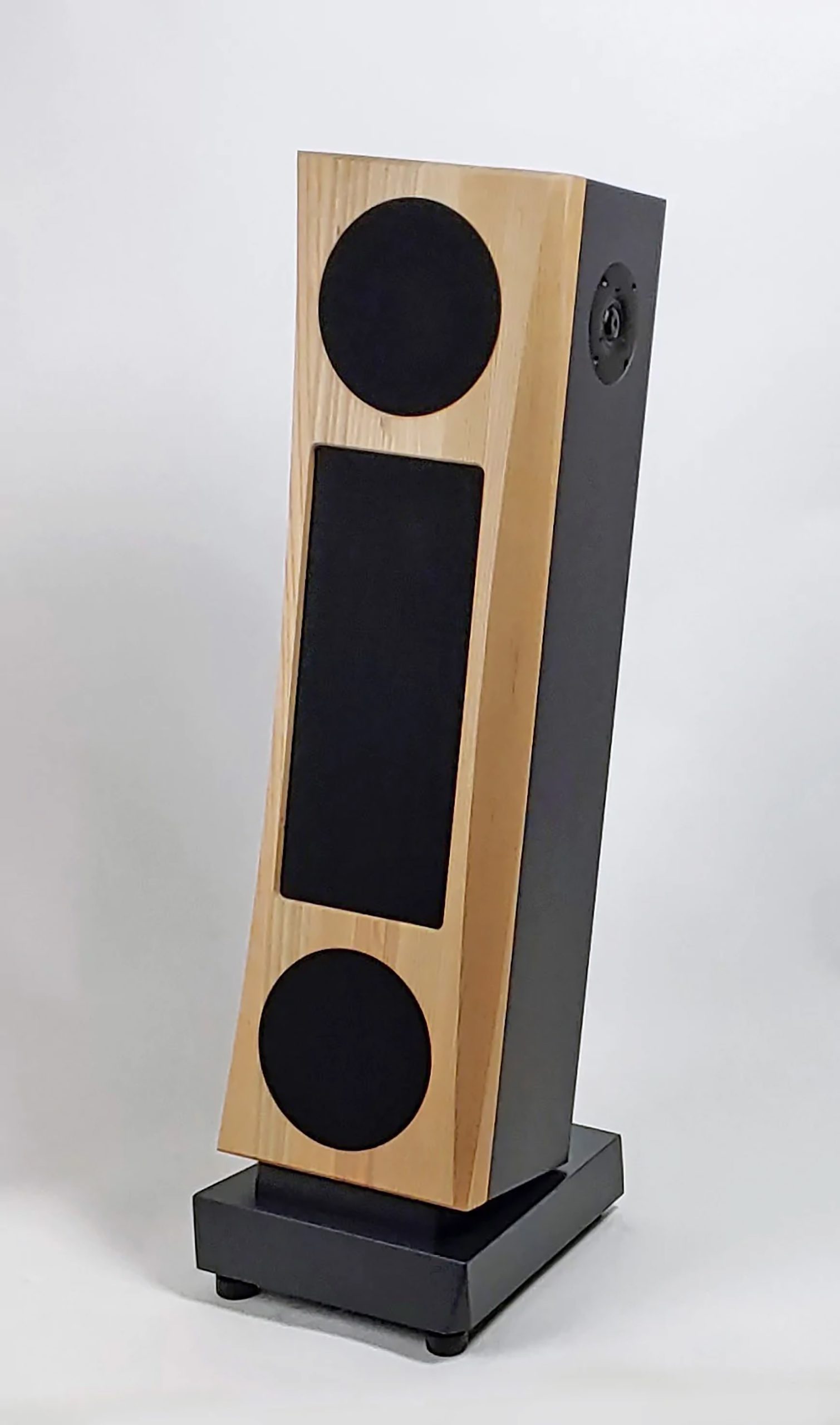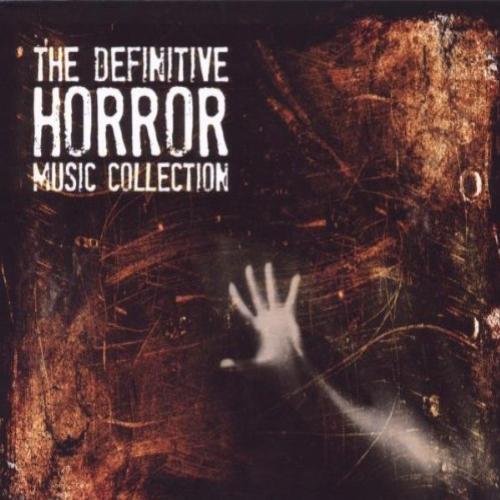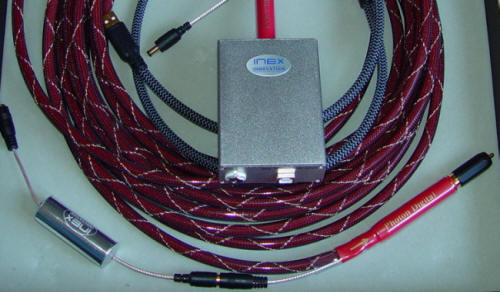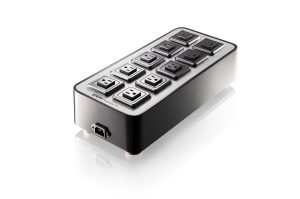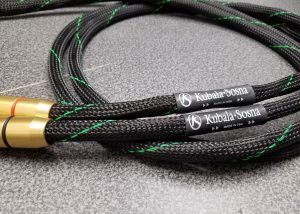
Most power line conditioners are passive, meaning the components that are doing the conditioning are in parallel to the power cord. This is done so that the conditioning components do not interfere with the instantaneous demand for power that happens with amplifiers when the music goes from very soft to very loud in a few milliseconds. The INEX Innovation 3D Creator Power Cord, which is being reviewed, is an active power line conditioner. As you can see in the two photos, The INEX power conditioner comes either as a normal power cord ($1,200) or as an inline filter ($900) that you can a put between your power cord of choice and your component.
How does the active INEX filter work? It is a proprietary design so INEX is reluctant to discuss the particulars. However, Mitch Ko, one of the designers, did say that the power cord is designed to only pass the 50/60Hz, 100 to 220 volt power signal. Smaller, out of band signals, which is the noise that is being carried along with the power signal, do not pass through.
At the time I was listening to the INEX power cords and filters I also had both the Audience aR6-TS ($4,995) and the Audience aR2p-TOS ($2075) power line conditioners at hand. Thus, I was able to do comparisons between the two Audience filters and the INEX power cords and filters. Mitch had told me to put the INEX four power chords and two filters that he had sent me into the system all at the same time for the best effect. After burning in the power cords and filters via my audiodharma Cable Cooker I did just that.
Prior to receiving the INEX power line conditioners I had not given much thought to power line conditioners. I have tried a number of them over the years and while they changed the sound I did not think the improvement, if any, was worth the price. With my system shut down I installed the two filters between the power cords on my mono block amps and the amps themselves. The four power cords I connected to my DAC, phono stage, pre amp, and the power distribution unit that supplies power to turntable motors and other ancillary equipment. I turned on the system and placed the Credence Gold LP, Fantasy 9418, on the turntable, dropped the needle and sat down to listen to the first track, Proud Mary. This is my favorite Credence Clearwater Revival LP and I am very familiar with all of the tracks on the album. The change in sound from not having the six INEX products to having the six in the system was significant. Equally important the change in sound was an improvement. The sound stage was wider and deeper. The noise floor had dropped. I could now hear details that I had never heard before. The music sounded more like live music.
For the next week I did not do any critical listening. I just played music, both analog and digital. The following week, figuring the cables were burned in and had time to settle down, I started the critical listening. The first thing I did was take all of the INEX cords and filters out of the system except for the one on the DAC. I then did A-B-A comparisons between the INEX power cord and the power cord that I had been using. I then moved the INEX power cord to my phono stage and again did the A-B-A comparisons between the INEX power cord and the power cord that I had been using on the phono stage. I repeated this process with the pre amp and then the mono block amps using two INEX power cords. The results of this one-on-one testing were interesting. To my ears the greatest improvement in sound was with the INEX power cord on the DAC followed by the phono stage and pre amp. This sort of makes sense since you would expect the equipment that was dealing with small signals to be more affected by noise entering the unit via the power cord0. But if that were true, then the phono stage should have shown the greatest improvement. I had also been expecting the amps, which are dealing with larger signals, would not be greatly effected. Wrong. The sound of the Herron mono block amps was also improved, though not quite to the same degree as the phono stage, pre amp, and DAC. The improvement in sound was significant and I was puzzled as to why. I called the designer of the amps, Keith Herron. I told him what I was doing. I told him that I knew he was very careful in designing his power supplies. Why then the big improvement with power line conditioning? Keith chuckled. Power supplies he said are designed to provide a stable current at a fixed voltage regardless of what is happening to the power signal coming out of the wall socket. Power supplies are usually not designed to be power line conditioners as that adds a whole series of technical problems to the design as well as substantially increasing costs if you are going to do it properly.
So what sonic differences did I hear when doing these A-B-A comparisons? The following is a condensed summary of the notes that I took regarding the improvements in sound quality that I heard when the INEX power cord was being used instead of my regular power cord on the DAC. My notes for the comparisons with the phono stage, preamp, and amps are similar....
Greatest Cinema Choral Classics, Fellowship of the Ring, A Knife in the Dark: Female vocal arises out of darker background.
Cinema Choral Classics II, Missa Lubas, Sanctus: The wooden sticks being clapped together seem louder with more resonance.
Cinema Choral Classics I, Carl Orff, Carmina Burana, O Fortuna: The soft vocals after the loud beginning are more distinct.
Cinema Choral Classics I, Lion in Winter Suite: Opening violins coming from darker background, lower strings and timpani have more resonance and texture, sound more like what I hear in concert hall.
Deliverance soundtrack, Dueling Banjoes: In the beginning when the guitar plays and the banjo repeats both instruments seem to have more complex harmonics emitting from the instruments.
Judas Priest, Turbo Lover, Turbo Lover: Darker background, music seems slightly louder even though volume unchanged, voices sound more realistic.
Ronn McFarlane, The Scottish Lute, Draw Near and Love Me: Darker background, a more intimate sound, a more you-are-there sound.
Rachmaninoff, Suite 1, 4th movement, Pacques for two pianos, Argerich and Rabinovich: Darker background, more like sound in a concert hall.
Dead Can Dance, Within the Realm of a Dying Sun, Dawn of the Iconoclast: Wider, deeper sound stage, Lisa Garrard's voice sounds more like a real human voice.
After doing these A-B-A comparisons I then did comparisons using the two Audience power line conditioners. This time I was comparing the sound of the DAC, phono stage, and pre amp plugged in the Audience aR6-TS and the mono blocks plugged into the aR2p-TOS versus the system with the INEX power chords on the DAC, phono stage, and pre amp and the two INEX filters on the amps. Once I had compared the two different systems I then started swapping the power cords of the individual components between INEX and Audience. By doing all of this swapping I was able to determine the sonic signatures of the Audience power line conditioners and the INEX power cords. The sound when using the two Audience power line conditioners was super smooth and silky. The INEX power cords did not have the silky smoothness of the Audience power line conditioners. If you heard the INEX power cords by themselves you would think the sound was wonderful. However, in direct comparison with the Audience power line conditioners the INEX sound had a slightly rougher texture. I would never have heard this slight roughness if I had not been doing the A-B-A comparisons. And I bet most audiophiles would also not be able to hear the sonic difference unless they were allowed to perform direct A-B listening tests of their own.
While the sound of the Audience power line conditioners was silky smooth, I found the INEX power cords had more extension, resonance, and visceral impact in the deep bass than did the Audience power line conditioners. I do not have a subwoofer in my system at the moment. I have no need for one as I have measured my Janszen zA2.1 speakers in my listening room and they were down 3dB at 25Hz. Since I am a lover of bass, I try to recreate in my listening room the sound I hear in the concert hall of the big bass drum being whacked and of the Hammer Stroke from Mahler’s Sixth slamming down. With the INEX power cords on the DAC, phono stage, and pre amp there is more energy and information in the low bass. It is not a huge difference, but a difference that most people would hear. When the INEX power cords were used on the amps the difference was even more apparent. In the end, after all the swapping and listening to the system, the sound that I preferred came from using the Audience aR6-TS on the front end and the INEX power cords on the amps. This is my personal preference. Your sonic preferences may differ significantly from mine.

Other things that I learned from all of this swapping and listening was that the sound quality of the INEX filter is highly dependent on the power cords being used with them. I have quite a few different power cords from various manufacturers that originally sold for US$750 to US$2,000. None of these power cords when connected to the INEX filter sounded as good as the INEX power cord itself. The cable used on the INEX power cords was obviously selected because it sounded the best. If you have mega-buck power cords you might want to try them with the INEX filter. However, the way I see things is that the INEX power cord gives you the $900 INEX filter with the best sounding cable for that filter for only $300 extra. How many great sounding power cords can you buy for US$300?
The approaches taken by Audience which requires plugging everything into one box versus the INEX approach of one power cord for each piece of equipment are radically different. Thus, if you are considering buying power line conditioning for your system you need to consider which approach will fit best with your system. If all of your equipment is plugged into one wall outlet, then the Audience approach is certainly the most efficient. On the other hand, if you only need power for your DAC and integrated amp, then the INEX power cords solution is cheaper. However, if like me, your equipment is powered from two or more different wall outlets, then that could require the use of more than one box. During my listening tests I experimented with using just the Audience aR6-TS to power everything. This required running Tripp Lite power strips with 15 foot cords across the room. This is aesthetically ugly and increases the danger of tripping. However, it does work in that there is little change in the sound caused by the 15 foot Tripp Lite power strip being inserted between the aR6-TS and the piece of equipment. I also tried plugging a INEX power cord into the wall and then plugging the power cord’s male IEC connector into the female IEC of a $500 power distribution strip. I then plugged my equipment into the power distribution slip. There was a noticeable degradation of the sound over having the INEX power cords plugged directly into the equipment. I believe that the degradation was caused by the power distribution unit adding its own signature and also due to my power cords not being as good as they should be. So the question for me is, should I buy five INEX power cords (5 X US$1200 = US$6000) or buy a aR6-TS (US$4995) and then upgrade my five existing power cords one by one at a cost of ???? X 5 = ????. Sigh. Nobody said being an audiophile was easy.
Conclusion
If you planning on spending significant dollars on power line conditioning you really need to listen to equipment from several different manufacturers. In this way you can determine which power line conditioner appeals to your particular music preferences. The INEX power cords should definitely be on your short list. If you only need a couple of power cords instead of a power line condition/power distribution unit, make sure you give the INEX power cords a listen. Highly recommended. Roger S. Gordon
INEX 3D Creator AC Power Cord
Retail: US$1200 for 1.5 meters. Longer lengths available.
INEX 3D Creator AC Filter
Retail: US$900
INEX Innovation
428 McCormick Street
San Leandro, CA 94577‑1005
(510) 567‑8503
[email protected]
www.inexinnovation.com
My audio system for this review:
Digital
- Music Server - Intel NUC, i5 processor, 16 GB RAM, JRiver software
- NAS - Synology 212se connected to NUC with CAT6 ethernet cable
- DAC - Lynx Studio Hilo ADC/DAC with analog volume control
- USB to S/PDIF - INEX Photon 1 and Photon USB2
Analog
- Pre Amp - Herron Audio VTSP-3A
- Amps - Herron Audio M1A mono blocks
- Speakers - Janszen zA2.1




